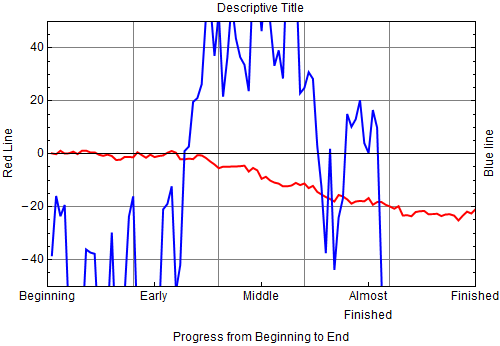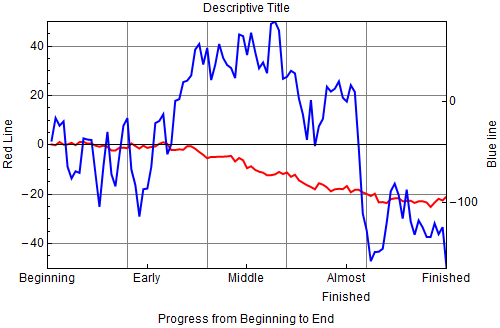Even though this question has been flagged as answered, I think the answers are more complicated than they need to be (with respect to the authors). I offer the following, which takes advantage of FrameTics:
(*create 2 lists*)
x1 = Accumulate[RandomVariate[NormalDistribution[0, 1], 100]];
x2 = 25 Accumulate[RandomVariate[NormalDistribution[0, 1], 100]];
(*set nice plot options*)
SetOptions[ListPlot, ImageSize -> 500, Frame -> True, Joined -> True,
GridLines -> Automatic, PlotStyle -> {{Thick, Red}, {Thick, Blue}},
PlotRange -> {{0, 100}, {-50, 50}},
FrameLabel -> {"Progress", "Red Line","Descriptive Title", "Blue line"},
LabelStyle -> {12, FontFamily -> "Arial"}];
(*display, using FrameTicks for the bottom axis to show what it does*)
ListPlot[{x1, x2},FrameTicks -> {{{0, "Beginning"}, {25, "Early"},
{50, "Middle"},{75,"Almost\nFinished"}, {100, "Finished"}}, Automatic, None,Automatic}]

As expected, x2 goes off ListPlot's range and needs a different scale. This can be accomplished by rescaleing x2 and using FrameTics to create a rescaled axis on the right. First, rescale x2 using the function rescaled[]:
datamax = Max[x2]; datamin = Min[x2];
datarange = datamax - datamin;
plotrange = 100; plotmin = -50;
rescaled[x_] := (x - datamin) plotrange/datarange + plotmin
Next, create new axis lables for the right axis::
axeslabel[v_] := {rescaled[v], ToString[v]}
rightaxis = Table[axeslabel[v], {v, -500, 500, 100}]
Finally, create the new ListPlot:
lp = ListPlot[{x1, x3},FrameTicks -> {{{0, "Beginning"}, {25, "Early"}, {50,
"Middle"}, {75, "Almost\nFinished"}, {100, "Finished"}}, Automatic, None, rightaxis}]
x3 = rescaled[#] & /@ x2;

See how easy that was!
Upon reflection my approach isn't too different from Peter Breitfeld's, except perhaps that I made a more general rescaling routine.
